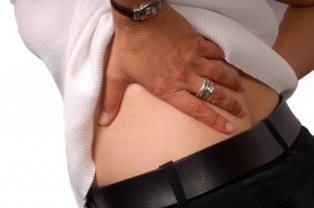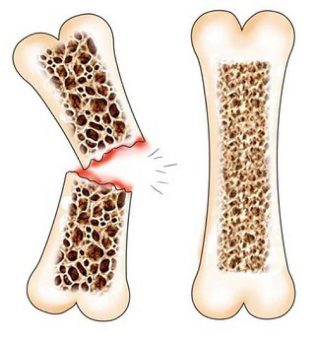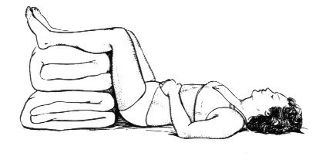Back pain occurs quite often. Patients say, "I have a bad back", "pinched waist", "the cross on the back". If the pain is inconsiderate, I can say "back pain", "pull back", "pain back". Sometimes the pain is described as burning in the lower part of the back.
The lower back is called low back - from the place where the end ribs to the coccyx. Perhaps a different word to refer to the waist was required in order to specify the place where it hurts. After all, if the back pain in the majority of cases, the pain came back.

That can be a pain
Most often, back pain occurs suddenly and sharply, acute. In this case we speak of lumbago (obsolete folk name of the cross). The pain is described as sharp, "shooting". Movement linked, sometimes even impossible to straighten the back. In any movement the pain increases.
The pain can last a few minutes, and can last a long time (several days). It may be that the attack will take place, and the pain more about you remember, but often the pain returns, and the person gets used to the lower back can hurt.
Back pain can be not only sharp (sharp), which can lead to toss of character and be chronic. A mild but constant pain in the loins, sometimes aggravated by, for example, during physical exertion, infectious diseases, colds, etc., is called the lumbar region. Sometimes there is no pain directly, but is stored in the lower part of the back stiffness the patient is experiencing discomfort.
Causes of lower back pain
Back pain can be caused by several reasons, but the statistics is the following:
- in 90% of cases the pain is caused by problems with the spine and the muscles of the back;
- 6% cause of pain is a kidney disease;
- 4% - diseases of other internal organs (urinary system, colon).
The fee of the spine account for the majority of all cases of back pain, and this is no accident. In humans, the center of gravity of the body is only at the level of the waist, and walk all the burden almost totally falls on the lumbar vertebrae (in animals that move on four legs, this is not a problem). And when a person sits down, the lumbar vertebrae and the sacrum is experiencing the same force of pressure that the diver presses of 170 meters of the water layer. Naturally, this is an area particularly vulnerable.
Diseases of the musculoskeletal system, causing back pain:
- a pinched sciatic nerve. The nerve roots extending from the spinal cord is squeezed by the vertebrae adjacent. When this happens, a sharp, shooting pain. Normally, the jams of the roots is made possible as a result of degenerative changes of the spine (osteochondrosis): intervertebral discs that separate the vertebrae of the other is destroyed, the gap between the vertebrae narrows and sudden movement (tilt, rotation) can lead to pinched nerve branch;
- sciatica (sciatica). The pinched nerve roots can become inflamed. The inflammation of the nerve roots is called sciatica (from lat. radicula - "root"); to indicate inflammation of the sciatic nerve is sometimes used a special name - sciatica. With the defeat of the sciatic nerve can be lumboischalgia - back pain, spreading of the thigh and the leg in the course of the sciatic nerve;
- herniated disk - protrusion of a fragment of the intervertebral disc into the spinal canal. Occurs as a result of injuries or degenerative changes of the spine (osteochondrosis);
- myositis of the lumbar muscles. Myositis is an inflammation of the skeletal muscles. Because of myositis muscles lumbar may be hypothermia or sudden tension.

Also back pain can be caused by such illnesses as multiple sclerosis, degenerative sacroiliitis, osteoporosis.
Prevention of back pain
The appearance of lower back pain is often caused by the attitude of negligence to their own health. The pain can be caused by:
- prolonged stay in the same position (for example, sedentary work);
- a bad posture;
- low mobility;
- excessive physical effort.
All these factors contribute to the development of the disease, is manifested by pain in the lower back. The risk of pain can be reduced if you observe the following tips for physicians:
- follow the carriage;
- avoid postures uncomfortable in the work of the sitting. It is desirable that the knee was slightly higher than in the area of the joints. Use a low chair or standing on its feet. Make a small pillow between the lower back and the seat back;
- when sedentary work has time to get up to move. Do it every hour, five-minute breaks, to lift weights
- it is advisable to sleep on a pillowtop mattress (elastic and resistant enough);
- to lift weights is necessary because of the bending of the knee, and not the back. That is to say, you should sit, bend your knees and then stretch them, keeping a straight line from the back;
- the displacement of the load must be evenly distributed between the two hands to carry the whole load by hand (a heavy bag);
- every day you should do a set of exercises meant to strengthen the muscles of the abdomen and back.
Lower back pain kidney disease
When back pain is important to determine what is the cause of the pathology of the musculoskeletal system or a disease of the kidneys (and other organs). Diagnosis should be done by a doctor. However, there is evidence to suggest that the pain may be caused by problems the kidneys or (and) other organs of the system, urogenital. The manifestation of these symptoms it is advisable to consult a doctor-urologist. Kidney disease (or wider - the genitourinary system) may be suspected, if the pain is accompanied by:
- the General deterioration of the illness (lethargy, drowsiness, weakness, fatigue);
- swelling of the eyelids, the face. The swelling is especially noticeable in the morning after waking up, and disappears for the night;
- the increase in body temperature, chills, sweating;
- loss of appetite, nausea, vomiting;
- the increase or urination painful;
- the change in the characteristics of the urine (may be more concentrated colour or Vice versa - a colorless, contain mucus or blood);
- the increase in blood pressure.
Also an important sign that the back pain caused by problems of the internal organs, and not the musculoskeletal system is its independence of the position of the body: changing the body position and limb pain is not amplified and not reduced. However, with a long stay in a position in the pathology check the pain can worsen. Has a value and localization of pain. If you have a kidney disease in the pain is often observed, on the one hand, (as they usually suffer just a kidney). Kidney pain may not be limited to the lower part of the back, and it was extended in the course of the ureter, to the groin, external genitalia, internal face of the thighs.
Back pain: what to do?
Back pain is a symptom of the disease, that requires treatment. Therefore, it is necessary to consult with a doctor. But in the case of a sudden attack of acute pain ("lumbago" typical sciatica), we first need to relieve the pain. Doctors advise:
- use slightly warm. Tie the waist woolen scarf or woolen belt;
- take the pain;
- you must take the posture that allows you to relax the muscles of the back. It is recommended to lie on your back on a hard flat surface (Board); the legs are raised and bent at the knees, because it is necessary to put a folded blanket or pillow. (The plant to go undesirable, you can blow a draft).
The proposed position is not a dogma. The patient should feel relieved, because there are other possible positions; for example, lying on the Table to put on your knees bent legs, holding between them a pad. You can try to lie on your stomach and stretch your legs, putting a pillow under the ankle. If the sharpness of the pain has been eliminated, this does not mean that the doctor is not necessary. Without proper treatment, the attacks are repeated, and the situation to deteriorate.

To what doctor to address with a complaint of low back pain?
When back pain is best to consult a therapist, because first of all, it is necessary to identify the disease that the organs cause pain. According to the results of the inspection, you may need to consult a medical specialist. Can be assigned:
- consult a neurologist for assessing the spine, the muscles of the back and nervous system;
- consult a doctor-urologist in the case of suspicion of disease of the urinary system;
- consultation of the gynecologist - in case of suspicion or presence of chronic diseases of the organs of the female reproductive system;
- General blood and urine to confirm or exclude the inflammatory nature of the disease;
- the x-ray of the spine ;
- Ultrasound of the hip joints ;
- as well as other studies.





































